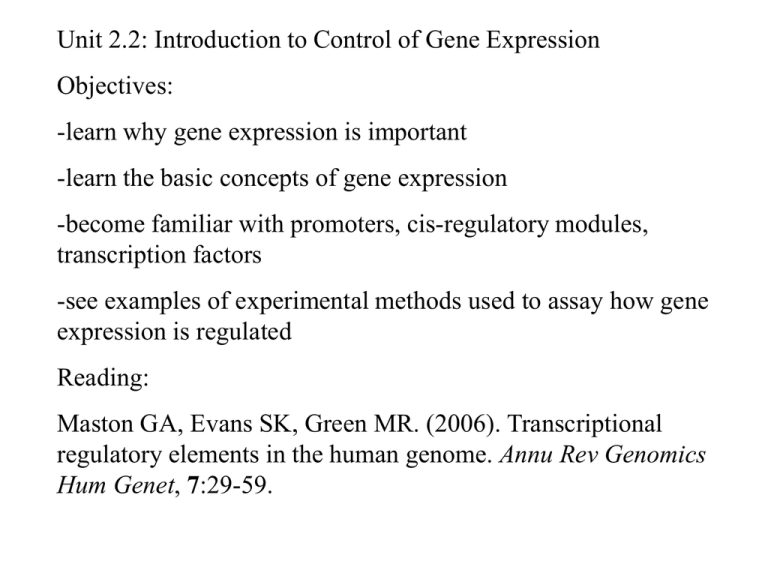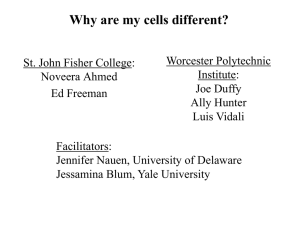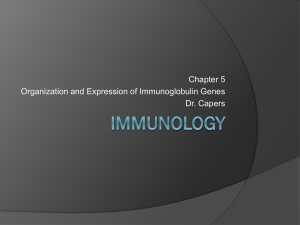Gene_expression
advertisement

Unit 2.2: Introduction to Control of Gene Expression Objectives: -learn why gene expression is important -learn the basic concepts of gene expression -become familiar with promoters, cis-regulatory modules, transcription factors -see examples of experimental methods used to assay how gene expression is regulated Reading: Maston GA, Evans SK, Green MR. (2006). Transcriptional regulatory elements in the human genome. Annu Rev Genomics Hum Genet, 7:29-59. Every cell has the same DNA and therefore the same genes. But different genes need to be “on” and “off” in different types of cells. Therefore, gene expression must be regulated. liver embryo muscle bone sperm (The first statement on this slide is not completely true. Which of these cells does not have exactly the same DNA as the other? Can you think of any other examples of cells in your body that have different DNA than most of the others?) Gene expression must be regulated in several different dimensions— In time: 10 wks 6 mos 14 wks 1 day 12 mos 18 mos At different stages of the life cycle, different genes need to be on and off. © M. Halfon, 2007 In space: Paddock S.W. (2001). BioTechniques 30: 756 - 761. Each colored stripe in this fly embryo shows the expression of a different gene or set of genes. The spatial regulation of these genes allows the embryo to be divided up into different regions that will give rise to the head, the internal organs, the abdomen, etc. and in abundance: Clyde et al. (2003). Nature 426:849-853 Note how the gene whose expression is indicated in blue varies in abundance from strong expression (bold arrow) to weak (thin arrow) within its expression domain. These differences in strength of gene expression have important functional consequences. Some of the many areas in which regulated gene expression plays a critical role are illustrated on the following slide. Gene regulation is important not only during development but also in mediating common variation between individuals, diseases and birth defects, and evolution. Importance of gene regulation common variation behavior pattern evolution chromosome inactivation metabolism pathology (mutation) © M. Halfon, 2006 Gene Regulation and Nutrition: Development (organs, cell types) muscle liver (diseased) fat embryo embryo brain intestines With respect to nutrition, gene regulation is important to guide the development of organs, tissues, and cell types required to ingest, digest, and metabolize nutrients. Gene Regulation and Nutrition: Metabolism (enzymes) high carb/low fat (sustained) insulin increased transcription fatty acid synthase acetyl-CoA carboxylase Your long-term diet can lead to permanent changes in your body’s gene expression profile Genes can be regulated at many levels DNA RNA TRANSCRIPTION PROTEIN TRANSLATION The “Central Dogma” click here and then select “Control of Gene Expression in Eukaryotes (959.0K)” for an animation on gene expression Control of Gene Expression—Transcription Factors Transcription factors (TFs) are proteins that bind to the DNA and help to control gene expression. We call the sequences to which they bind transcription factor binding sites (TFBSs), which are a type of cis-regulatory sequence. Determining Transcription Factor Binding Sites One way to determine where a TF binds is to use DNAseI footprinting, which takes advantage of the ability of the enzyme DNAseI to non-specifically cleave DNA. A bound TF “protects” the DNA from cleavage, leaving a visible “footprint” when the digested DNA is visualized by gel electrophoresis. Figure 8-54. The DNA footprinting technique. (A) This technique requires a DNA molecule that has been labeled at one end (see Figure 8-24B). The protein shown binds tightly to a specific DNA sequence that is seven nucleotides long, thereby protecting these seven nucleotides from the cleaving agent. If the same reaction were performed without the DNA-binding protein, a complete ladder of bands would be seen on the gel (not shown). (B) An actual footprint used to determine the binding site for a human protein that stimulates the transcription of specific eucaryotic genes. These results locate the binding site about 60 nucleotides upstream from the start site for RNA synthesis. The cleaving agent was a small, iron-containing organic molecule that normally cuts at every phosphodiester bond with nearly equal frequency. (B, courtesy of Michele Sawadogo and Robert Roeder.) Source: Alberts et al., Molecular Biology of the Cell Determining Transcription Factor Binding Sites Other methods include - EMSA (gel shift) - SELEX (Systematic Evolution of Ligands by EXponential enrichment) -protein-binding microarrays -ChIP-chip/ChIP-seq Control of Gene Expression—Transcription Factors Most transcription factors can bind to a range of similar sequences. We call this a binding “motif.” Wasserman, W. W. and A. Sandelin (2004). Nat Rev Genet 5(4): 276-287. (We can represent these motifs in various ways, which we will see in Unit 2.5) Control of Gene Expression Transcription factor binding sites are found within larger functional units of the DNA called cis-regulatory elements. There are two main type of cis-regulatory elements: promoters, and cis-regulatory modules (sometimes called “enhancers”). cis-regulatory module (CRM) TFBS transcription factor binding site (TFBS) TFBS Image adapted from Wolpert, Principles of Development Control of Gene Expression: Promoters Every gene has a promoter, the DNA sequence immediately surrounding the transcription start site. The promoter is the site where RNA polymerase and the so-called general transcription factors bind. Control of Gene Expression: CRMs Additional gene regulation takes place via the cis-regulatory modules (CRMs), which can be located 5’ to, 3’ to, or within introns of a gene. CRMs can be very far away from the gene they regulate—over 50 kb—and other genes might even lie in between! cis-regulatory module (CRM) TFBS TFBS transcription factor binding site (TFBS) click here and then select “Transcription Complex and Enhancers (586.0K)” for an animation on gene expression cis-Regulatory Modules (enhancers) Genes are often regulated in a modular fashion—discrete cis-regulatory elements (CRMs, “enhancers”) dictate a specific spatio-temporal expression pattern, shown here by purple stain. A gene might have many CRMs, each responsible for a different part of its overall expression pattern. eve Map of 3’ regulatory region of Drosophila even skipped (Fujioka et al. 1999) Looking at cis-regulatory modules: Reporter Genes How can we identify and study CRMs? To do this we use a reporter gene assay. In such an assay, we use recombinant DNA methods to test if a DNA sequence can regulate the expression of a gene whose expression we can easily identify (a “reporter gene”). The jellyfish green fluorscent protein (GFP) gene is often used, as the encoded protein emits green light when exposed to light of the proper wavelength. We can test for CRM activity in transfected cells in culture, or even better, in a transgenic animal: Looking at cis-regulatory modules: Reporter Genes cis-regulatory module (CRM) TFBS TFBS CRM e.g., from Myosin Heavy Chain gene muscle transcription factor binding site (TFBS) minimal promoter green fluorescent protein Looking at cis-regulatory modules: Reporter Genes CRM minimal promoter green fluorescent protein reporter construct transfect cells make transgenic animal A nutritional example: the lactase gene © M. Halfon, 2007 A nutritional example: the lactase gene Many adult humans cannot metabolise lactose (milk sugar). A single nucleotide polymorphism (SNP), i.e., a one basepair difference in DNA sequence, correlates with activation of the lactase promoter and with lactose tolerance/intolerance. Moreover, this simple change can be seen to affect the binding activity of a transcription factor, Oct-1, to the relevant CRM. There are likely to be many such instances of how changes in gene regulation affect nutrition, health, and disease, although most remain to be discovered. agataatgtagTccctggcctca agataatgtagCccctggcctca ability to activate Oct-1 binding phenotype ++ ++ tolerant + + intolerant Olds, L. C. and E. Sibley (2003). Hum. Mol. Genet. 12(18): 2333-2340.







